 For many years, Wireless Waffle has enjoyed the occasional bout of FM DXing. That is to say that when the propagation conditions have permitted, time has been enjoyably spent tuning up and down the FM band to see what can be heard.
For many years, Wireless Waffle has enjoyed the occasional bout of FM DXing. That is to say that when the propagation conditions have permitted, time has been enjoyably spent tuning up and down the FM band to see what can be heard.The logbook of this anomalous reception has been sitting waiting to be published for ages and now, with a quiet weekend with not much else to do has presented itself, it's finally morphed into a web-page of it's own.
Wireless Waffle is therefore proud to announce the FM DX Logbook. If this means nothing to you, then don't take a look. Even if it does, just one look is all it takes, as someone wiser and more lyrical once suggested.
add comment
( 1608 views )
| permalink
| 



 ( 3 / 30460 )
( 3 / 30460 )




 ( 3 / 30460 )
( 3 / 30460 )
Back in December when we discussed the launch of Radio Caroline on 648 kHz and suggested that they were using wider bandwidth AM, Mike left a comment concerning Stereo AM. Stereo AM makes a great article for a post, so here we go!
AM broadcasting in the medium-wave (MW) band is traditionally mono only. Back in the early 1980's four competing technologies were running trials of AM stereo, and in 1988 a solution proposed by Motorola called Compatible-Quadrature Amplitude Modulation (C-QUAM) which had gained significant popularity, was chosen as the de-facto standard in the USA (it was formally adopted in 1993). The word 'compatible' refers to the fact that one of the primary criteria for the solution was that an 'old fashioned' mono AM receiver would not notice any difference when tuned to an AM-stereo signal, that is to say that it would continue to receive a mono signal as if nothing had changed. Thus the stereo signal would remain compatible with mono receivers (note that exactly the same is true of FM stereo).
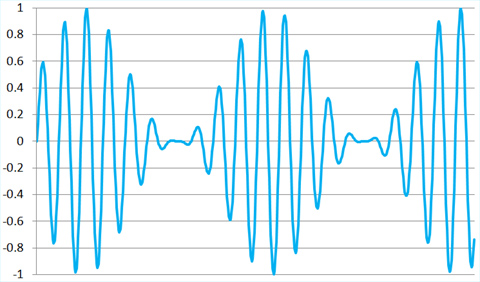 The C-QUAM solution used the properties of AM and of FM to do something novel. In an AM waveform (as shown on the right), the information (in this case audio) is imposed onto the transmission frequency (the 'carrier wave') by changing the amount of power transmitted, that is to say, changing the amplitude of the transmission and hence amplitude modulation (AM). At the receiver, only the amplitude of the signal is used to recover the data.
The C-QUAM solution used the properties of AM and of FM to do something novel. In an AM waveform (as shown on the right), the information (in this case audio) is imposed onto the transmission frequency (the 'carrier wave') by changing the amount of power transmitted, that is to say, changing the amplitude of the transmission and hence amplitude modulation (AM). At the receiver, only the amplitude of the signal is used to recover the data.
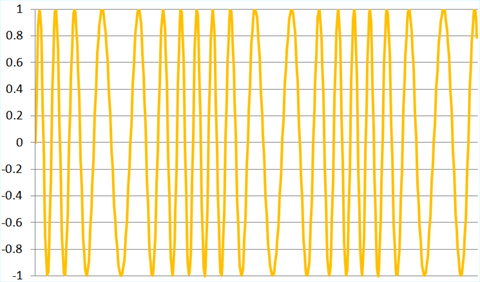 For an FM system, the amplitude or power of the transmitter remains the same and only the frequency is varied, hence frequency modulation (FM). In reality, the amplitude of the signal at the receiver will often vary, especially if the receiver is mobile, but as long as the signal that arrives at the receiver is strong enough to overcome any background noise, the receiver will still be able to detect what frequency was being transmitted and recover the original data or audio.
For an FM system, the amplitude or power of the transmitter remains the same and only the frequency is varied, hence frequency modulation (FM). In reality, the amplitude of the signal at the receiver will often vary, especially if the receiver is mobile, but as long as the signal that arrives at the receiver is strong enough to overcome any background noise, the receiver will still be able to detect what frequency was being transmitted and recover the original data or audio.
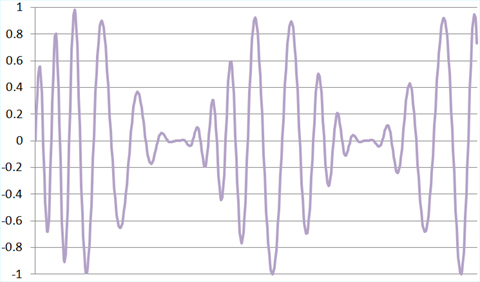 What Motorola did was to use both FM and AM at the same time. It is not as easy to see what is going on in the C-QUAM waveform shown on the right, but the principle is fairly straightforward. If you feed this signal into an AM receiver, it will only detect the changes in amplitude and will ignore the changes in frequency completely. If you feed this signal into an FM receiver, the opposite happens and the AM part of the signal is ignored and only the information modulated on the FM part of the signal is decoded. Hence you can send two sets of information at the same time, one using AM and the other FM.
What Motorola did was to use both FM and AM at the same time. It is not as easy to see what is going on in the C-QUAM waveform shown on the right, but the principle is fairly straightforward. If you feed this signal into an AM receiver, it will only detect the changes in amplitude and will ignore the changes in frequency completely. If you feed this signal into an FM receiver, the opposite happens and the AM part of the signal is ignored and only the information modulated on the FM part of the signal is decoded. Hence you can send two sets of information at the same time, one using AM and the other FM.
Compatibility is maintained by sending the Left and Right signals added together on the AM element of the transmission, and the 'stereo difference' (Left minus Right) on the FM part. Thus a mono AM receiver will see no change, but a stereo FM receiver will be able to add the mono and difference signals together to recover the original stereo signal. This is the same principle that applies for stereo FM broadcasting, though the method of transmitting the sum and difference signals are different.
The C-QUAM system is actually a little more complex than the description I have given above, for example, a pilot signal is added into the FM part of the signal to alert receivers that the transmission they are receiving is in C-QUAM, but the logic is in principle the same.
There are lots of videos of C-QUAM AM stereo on YouTube, but the one below is perhaps one of the best illustrations of what it sounds like on-air. It's actually fairly impressive.
So why is it that you've probably never heard of Stereo AM before? Here are some thoughts:
AM broadcasting in the medium-wave (MW) band is traditionally mono only. Back in the early 1980's four competing technologies were running trials of AM stereo, and in 1988 a solution proposed by Motorola called Compatible-Quadrature Amplitude Modulation (C-QUAM) which had gained significant popularity, was chosen as the de-facto standard in the USA (it was formally adopted in 1993). The word 'compatible' refers to the fact that one of the primary criteria for the solution was that an 'old fashioned' mono AM receiver would not notice any difference when tuned to an AM-stereo signal, that is to say that it would continue to receive a mono signal as if nothing had changed. Thus the stereo signal would remain compatible with mono receivers (note that exactly the same is true of FM stereo).
 The C-QUAM solution used the properties of AM and of FM to do something novel. In an AM waveform (as shown on the right), the information (in this case audio) is imposed onto the transmission frequency (the 'carrier wave') by changing the amount of power transmitted, that is to say, changing the amplitude of the transmission and hence amplitude modulation (AM). At the receiver, only the amplitude of the signal is used to recover the data.
The C-QUAM solution used the properties of AM and of FM to do something novel. In an AM waveform (as shown on the right), the information (in this case audio) is imposed onto the transmission frequency (the 'carrier wave') by changing the amount of power transmitted, that is to say, changing the amplitude of the transmission and hence amplitude modulation (AM). At the receiver, only the amplitude of the signal is used to recover the data. For an FM system, the amplitude or power of the transmitter remains the same and only the frequency is varied, hence frequency modulation (FM). In reality, the amplitude of the signal at the receiver will often vary, especially if the receiver is mobile, but as long as the signal that arrives at the receiver is strong enough to overcome any background noise, the receiver will still be able to detect what frequency was being transmitted and recover the original data or audio.
For an FM system, the amplitude or power of the transmitter remains the same and only the frequency is varied, hence frequency modulation (FM). In reality, the amplitude of the signal at the receiver will often vary, especially if the receiver is mobile, but as long as the signal that arrives at the receiver is strong enough to overcome any background noise, the receiver will still be able to detect what frequency was being transmitted and recover the original data or audio. What Motorola did was to use both FM and AM at the same time. It is not as easy to see what is going on in the C-QUAM waveform shown on the right, but the principle is fairly straightforward. If you feed this signal into an AM receiver, it will only detect the changes in amplitude and will ignore the changes in frequency completely. If you feed this signal into an FM receiver, the opposite happens and the AM part of the signal is ignored and only the information modulated on the FM part of the signal is decoded. Hence you can send two sets of information at the same time, one using AM and the other FM.
What Motorola did was to use both FM and AM at the same time. It is not as easy to see what is going on in the C-QUAM waveform shown on the right, but the principle is fairly straightforward. If you feed this signal into an AM receiver, it will only detect the changes in amplitude and will ignore the changes in frequency completely. If you feed this signal into an FM receiver, the opposite happens and the AM part of the signal is ignored and only the information modulated on the FM part of the signal is decoded. Hence you can send two sets of information at the same time, one using AM and the other FM.Compatibility is maintained by sending the Left and Right signals added together on the AM element of the transmission, and the 'stereo difference' (Left minus Right) on the FM part. Thus a mono AM receiver will see no change, but a stereo FM receiver will be able to add the mono and difference signals together to recover the original stereo signal. This is the same principle that applies for stereo FM broadcasting, though the method of transmitting the sum and difference signals are different.
The C-QUAM system is actually a little more complex than the description I have given above, for example, a pilot signal is added into the FM part of the signal to alert receivers that the transmission they are receiving is in C-QUAM, but the logic is in principle the same.
There are lots of videos of C-QUAM AM stereo on YouTube, but the one below is perhaps one of the best illustrations of what it sounds like on-air. It's actually fairly impressive.
So why is it that you've probably never heard of Stereo AM before? Here are some thoughts:
- Though a number of stations (particularly in the USA, Canada, Japan and Australia) did adopt the standard, there may have been insufficient stations on-air for consumers to properly experience the difference.
- The cost of receivers was always higher than mono ones as they were far more complex. This was exacerbated for a while as Motorola held the patents for the system and would have charged manufacturers a handsome fee to adopt it (they were forced to remove such payments in 1993 in the US when the FCC formally adopted the system).
- The quality of transmission of AM stereo, though better than AM mono, was not competitive with FM stereo which, by the time the C-QUAM standard had been adopted, were far more widespread than when the original AM stereo trials began.
- Maybe, and this is just supposition, the types of station on AM were in themselves less popular than the growing FM market, or possibly in some cases the programme material (e.g. talk) was not well suited to stereo.
Wednesday 22 November, 2017, 15:31 - Broadcasting, Licensed, Pirate/Clandestine
Posted by Administrator
Posted by Administrator
 Wireless Waffle previously sang the praises of the boat trips to visit the Ross Revenge, the home of former radio pirate, Radio Caroline. We also noted that they had been awarded a licence to operate a 1 kiloWatt transmitter on 648 kHz in the Suffolk and north Essex area.
Wireless Waffle previously sang the praises of the boat trips to visit the Ross Revenge, the home of former radio pirate, Radio Caroline. We also noted that they had been awarded a licence to operate a 1 kiloWatt transmitter on 648 kHz in the Suffolk and north Essex area.Well, it seems the engineering bods on the east coast have managed to get it together, and recently test transmissions on 648 kHz were spotted by a number of listeners, such as a DXer in Humberside who posted the video below on YouTube.
Though you may not be able to interpret the waterfall display shown on the video, what you see is the Radio Caroline signal in the middle. The two bright lines either side represent radio stations on the adjacent frequencies (639 and 657 kHz respectively). Normally, for AM broadcasting, each station would be allowed to occupy half of the bandwidth between its assigned frequency and the adjacent channels, meaining that it would extend +/- 4.5 kHz either side of its centre frequency. It is this limitation they gives medium and long wave broadcasting their characteristic 'muddy' sound, as the limitation in spectrum also restricts the amount of audio bandwidth that can be transmitted.
It's therefore notable that the Radio Caroline transmission on 648 kHz extends far closer to the adjacent frequencies than 4.5 kHz. It appears closer to +/- 6.5 kHz wide (or maybe even more). This would allow the station to transmit a wider audio bandwidth and thus sound a little 'brighter' on-air. Such derogations from the norm are not unusual as the medium wave band has become emptier, as there is more space for stations to spread out and sound better.
As an example, the three audio clips below have been filtered with different bandwidths. Just click on the relevant button to hear the difference (note that this doesn't work in all browsers.
| Audio Bandwidth | Play |
|---|---|
| 15 kHz, stereo (FM Stereo) | |
| 6.5 kHz, mono (extended bandwidth AM) | |
| 4.5 kHz, mono (standard bandwidth AM) |
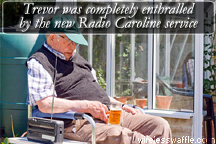 Given that of the neighbouring frequencies, the nearest stations on 639 kHz are in the Czech Republic and Spain (previously crowned the queen of medium-wave broadcasting) and on 657 kHz in Spain (again) and North Wales, it seems unlikely that the additional bandwidth being used by Radio Caroline will give any problems and we are sure that listeners will enjoy the cleaner, brighter sound that they will have on-air.
Given that of the neighbouring frequencies, the nearest stations on 639 kHz are in the Czech Republic and Spain (previously crowned the queen of medium-wave broadcasting) and on 657 kHz in Spain (again) and North Wales, it seems unlikely that the additional bandwidth being used by Radio Caroline will give any problems and we are sure that listeners will enjoy the cleaner, brighter sound that they will have on-air.Tuesday 21 November, 2017, 10:27 - Broadcasting, Licensed, Spectrum Management
Posted by Administrator
Posted by Administrator
 Digital UK, the organisation responsible for promoting digital terrestrial television in the UK, has recently published a white paper it commissioned from consultants Aetha and Webb Search entitled 'The defragmentation dividend: A more efficient use of the UHF band'. The paper hypothesises that by re-organising the UHF (e.g. sub 1 GHz) spectrum available to mobile operators, it would be possible to use it more efficiently and deliver more service from the same amount of spectrum.
Digital UK, the organisation responsible for promoting digital terrestrial television in the UK, has recently published a white paper it commissioned from consultants Aetha and Webb Search entitled 'The defragmentation dividend: A more efficient use of the UHF band'. The paper hypothesises that by re-organising the UHF (e.g. sub 1 GHz) spectrum available to mobile operators, it would be possible to use it more efficiently and deliver more service from the same amount of spectrum.The paper identifies the fact that, at present, the 'digital dividend' spectrum (e.g. that which has been released from television broadcasting due to the increased efficiency of digital transmission over its old analogue counterpart), is broken up into a number of fragmented pieces whose usage is not optimum. This is certainly true: the figure below shows the current set of allocations within the frequency range 694 - 960 MHz.

The mobile allocations at present are as follows:
| Band | Uplink (MHz) | Downlink (MHz) | Amount (MHz) | Notes |
|---|---|---|---|---|
| 900 MHz | 876-915 | 921-960 | 78 | Including GSM-R |
| 800 MHz | 832-862 | 791-821 | 60 | |
| 700 MHz (a) | 703-733 | 758-788 | 60 | FDD |
| 700 MHz (b) | 738-753 | 15 | TDD or Downlink | |
| TOTAL | 213 | |||
In addition there is approximately 29 MHz set-aside for short-range devices. Thus, of the total of 266 MHz of spectrum between 694 and 960 MHz, 213 MHz (80%) is allocated to mobile services, 29 MHz (11%) for short-range devices leaving 24 MHz (9%) 'empty' (mostly for guard-bands to protect services on adjacent frequencies from interfering with each other). The theory is that by re-arranging the band, it is possible to use all of the small gaps that currently exist between the various mobile allocations (e.g. the 9% that is empty) for more mobile services.
One of the problems of the plans proposed in the report is that although they increase the amount of spectrum for mobile services to up to 250 MHz in their most extreme case, they also reduce the amount available for short-range devices from 29 MHz to just 16 MHz. Whilst you may be thinking, "isn't mobile a better use of spectrum than short-range devices", the fact is that an increasingly wide ecosystem of devices is supported in this spectrum. It includes radiomicrophones and wireless headphones but perhaps even more critically, a growing number of Internet of Things (IoT) technologies that are seen by many as being at the centre of the next stages in the development of the Internet. This includes sensors (e.g. thermostats, light sensors), smart meters (electricity, gas and water) and a wide range of smart-city applications such as transport management. Digital UK's proposed plans involve changing the frequencies used by these devices, which is notoriously difficult. How long, for example, do the keyfobs that unlock your car door last - as long as the vehicle itself in most cases. So clearing a short-range device frequency won't be completed until every device in a band has been replaced by a new one.
The report only pays passing comment to the new 600 MHz mobile band that is being implemented in the USA. In fact, the report seems to suggest that even its most conservative re-organisation option would release so much capacity that there would be no need for the 600 MHz band:
...even the more modest increase of 25% in Option 1 would be similar to the capacity that could be provided by repurposing the 600MHz band...
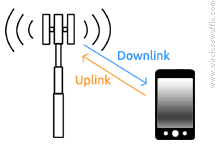 It makes this claim as a result of an oddity of current mobile technology, in which the amount of spectrum (and capacity) that is available to a mobile user is roughly equally split in the uplink and downlink directions (e.g. to the network from the user, and from the network to the user respectively). If the band was re-purposed as Time Division Duplex (TDD), the share of uplink and downlink capacity can be changed, and the report assumes that 80% of overall capacity would be made available for downlink and 20% for uplink (this is in fact in line with current estimates of the real split of usage). If this is the crux of the argument, then doing nothing at all to actually change the overall amount of mobile capacity available, but changing all of the existing allocations to TDD would approximately yield a 60% 'improvement' in downlink capacity, but this would be to the loss of uplink capacity which would fall by 250%! There is no gain without pain. In addition, TDD operators in adjacent mobile spectrum need to fully synchronise their networks otherwise there needs to be a guard-band between them, reducing the overall efficiency of use and opening up new gaps.
It makes this claim as a result of an oddity of current mobile technology, in which the amount of spectrum (and capacity) that is available to a mobile user is roughly equally split in the uplink and downlink directions (e.g. to the network from the user, and from the network to the user respectively). If the band was re-purposed as Time Division Duplex (TDD), the share of uplink and downlink capacity can be changed, and the report assumes that 80% of overall capacity would be made available for downlink and 20% for uplink (this is in fact in line with current estimates of the real split of usage). If this is the crux of the argument, then doing nothing at all to actually change the overall amount of mobile capacity available, but changing all of the existing allocations to TDD would approximately yield a 60% 'improvement' in downlink capacity, but this would be to the loss of uplink capacity which would fall by 250%! There is no gain without pain. In addition, TDD operators in adjacent mobile spectrum need to fully synchronise their networks otherwise there needs to be a guard-band between them, reducing the overall efficiency of use and opening up new gaps.Whilst the report makes a valid argument about whether the future of mobile should be TDD or FDD, it is perhaps no surprise that it chooses this solution to theorise about an improvement in the efficiency of use of UHF spectrum, over and above the use of the new 600 MHz band, whose use would obviously entail the loss of (yet) more spectrum for digital terrestrial television. Sadly for Digital UK, the required pain, in terms of re-organising existing mobile networks, and replacing all short-range devices is sadly never going to counterbalance the gain of a few extra MHz of UHF spectrum.

